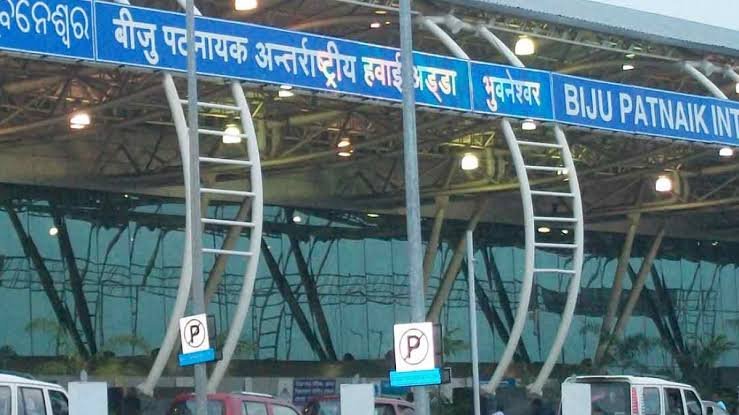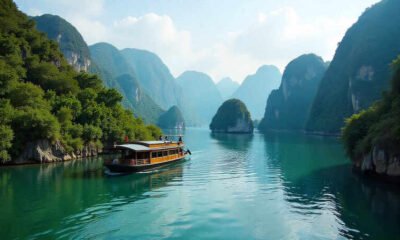Travel Guides & Articles
10 incredible hotels that take travel to new heights (and depths)

Luxury, today, is learning to hold your breath. It is sleeping 400 meters above Peru’s Sacred Valley in a glass capsule or sinking into a Maldivian villa where parrotfish flicker in place of bedside lamps. Such settings are not simply hotels but vantage points. The impulse is not new—humans have long sought the thrill of the precarious or the eerie in remote landscapes—but the internet and the ease of global travel have multiplied access to such extremes. What once belonged to explorers or the deeply adventurous is now packaged, photographed, and shared in real time.
The effect on the psyche is subtle but unmistakable: these experiences reorder our sense of safety, blur the boundary between fear and wonder, and remind us that true comfort often sharpens, rather than shields, our awareness of the world’s edges. Here’s a curated list of hotels, where luxury is measured less by thread count than by proximity to the unfamiliar. They invite us to dwell—briefly—on the threshold between peril and wonder, and to consider how comfort feels when it leans against the edge of the world.
Hanging above the Andes
High above Peru’s Sacred Valley, Skylodge Adventure Suites offer the kind of stay that redefines “room with a view”. Guests sleep in transparent capsules bolted to a cliff face, reached only by scaling a via ferrata or swooping in on a zipline. It is equal parts adrenaline rush and luxury escape—think dangling 400 metres in the air, glass walls framing the Andes, and waking up to sunrise over Incan lands. Opened in 2013, this is the world’s first hanging lodge.But do not mistake it for roughing it. Packages include private transport, bilingual guides, full gear, and the kind of meals that make the climb worthwhile—gourmet dinner with wine and breakfast served quite literally above the clouds. More than a night’s rest, Skylodge is a high-fashion brush with danger: a travel story that is as daring as it is dazzling.
A villa underwater, a sunrise above
At The Muraka, Conrad Maldives’ iconic undersea villa, luxury takes a surreal turn. Picture a glass-walled bedroom sunk 16 feet below the Indian Ocean, where parrotfish drift by as you fall asleep. Above water, sleek living spaces, a private deck, and a butler keep things effortlessly chic.To dine under the glass dome of Ithaa, the world’s first underwater restaurant, is nothing short of an adventure. You can plant coral to leave your mark on the reef, sip vintages in Maldives’ first underground cellar, or stargaze over a private dinner. It is barefoot elegance meets oceanic fantasy—a dream where every sunrise writes a new page of paradise.
Where the guests never leave
Perched high in the Ozark Mountains, the 1886 Crescent Hotel & Spa is not just a grand historic getaway—it is famously billed as America’s most haunted hotel. From Michael the stonecutter’s mischievous spirit to Theodora the mysterious patient and the lingering “ghost in the morgue,” its corridors brim with legends that have lured thrill-seekers for decades. Guests can join nightly ghost tours ending in Norman Baker’s infamous morgue or take part in midnight investigations led by seasoned hunters. Whether chasing whispers in the dark or savouring the old-world charm of Eureka Springs, this mountaintop retreat is a rare destination where history and hauntings share the same room.
A retreat nestled 1,375 feet underground
Tucked 1,375 feet beneath the peaks of Snowdonia, Deep Sleep is less a hotel stay and more a descent into another world. Guests trek through misty mountains, clip on helmets, and navigate crumbling miners’ stairways before arriving at a hidden chamber where four sleek cabins and a romantic grotto room await.
It is a curious mix of raw and refined: expedition suppers served at a communal table, Wi-Fi powered by underground streams, thick bedding against the cave’s eternal chill. By morning, after the quietest sleep of your life, you climb back toward daylight with a story no luxury spa can rival—you have slept deeper than anyone else on Earth.
Amsterdam’s suite in the sky
Suspended high above the NDSM wharf, the Faralda Crane Hotel reimagines Amsterdam’s industrial heritage as pure fantasy. This 1950s harbour crane, rescued from demolition and meticulously restored, now houses three suites—each suspended 55 metres in the air, with sweeping views that feel almost cinematic.
Guests slip into a world where exclusivity is the rule: a rooftop spa pool that hovers above the city, a studio pulsing with music and art, and spaces that have lured the world’s leading DJs, visionaries, and luxury brands. Faralda does not pander to the mainstream—it curates experiences that are as daring as the structure itself. What was once rust and rivets is now one of Europe’s most audacious sanctuaries, where history, design, and fantasy entwine.
On safari from a bridge
A reimagined 1920s rail safari, Kruger Shalati is luxury with a heartbeat of history. Perched above the Sabie River on the historic Selati Bridge, this one-of-a-kind lodge transforms vintage train carriages and bridge-side suites into an immersive sanctuary. It is a front-row seat to Africa’s wild theatre—elephants at the water, birds at dawn, and sunsets that feel cinematic.
More than design, it is the story that piques your interest: named after Shalati, the warrior queen, the lodge embodies strength, culture, and connection. Expect private decks, an overhanging pool, soulful African cuisine, and game drives into Big Five territory—all wrapped in hospitality that feels personal and poetic.
A hotel carved from ice
In the tiny Swedish village of Jukkasjärvi, 200 kilometres north of the Arctic Circle, an otherworldly landmark rises from the frozen Torne River each winter: the ICEHOTEL. Since 1989, artists and designers from around the globe have sculpted its shimmering halls anew, turning blocks of ice into a fleeting wonder of architecture, design, and imagination.But the ICEHOTEL is far more than a place to sleep beneath glacial chandeliers. Guests can chase the northern lights, bask in the midnight sun, ride dog sledges across Lapland’s wilderness, or share a meal crafted from local ingredients—sometimes served on plates of ice. Holiday packages here range from winter expeditions and sauna rituals to summer journeys. There are deluxe suites and overnight sledge tours for those craving extravagance and adventure.
Luxury at the edge of the earth
ION Hotels distil Iceland’s magic into an experience that is equal parts wild and refined. Rising out of lava fields, the striking ION Adventure Hotel feels like a modernist outpost at the edge of the earth, while ION City in Reykjavík offers a chic urban retreat with the same soul. Both fuse raw nature with clean design, creating spaces where glaciers, geysers, and Northern Lights are not just backdrops but part of the story. What elevates ION is its quiet luxury—the kind found in thoughtful details and genuine warmth. While guests rave about the Northern Lights Lounge, geothermal saunas, and menus rooted in farm-to-table freshness, it is the human touch that lingers: staff who remember your journey, celebrate your milestones, and make Iceland feel not just extraordinary, but personal.
Sleeping with the Atlantic below
Balanced on steel legs in the middle of the Atlantic, the Frying Pan Hotel is part survival story, part adventure fantasy. Once a 1960s Coast Guard light station, it now dares guests to swap plush comforts for the thrill of shark-dotted waters, helicopter landings, and sunsets that burn straight into the horizon. This is not a retreat for the faint-hearted—it is where the wild ocean is your front yard and the only luxury is the adrenaline rush.
Here, extreme meets unforgettable: hammocks strung high above crashing waves, scuba dives into protected reefs, and golf balls made of fish food flung into the sea. Frying Pan Tower is equal parts eco-station, research hub, and bucket-list stay. It is not about five-star pampering, but the bragging rights of sleeping at the edge of the Atlantic’s fierce beauty, where few would dare.
The Pink Lady awaits
At Asheville’s storied Grove Park Inn, legend lingers as vividly as the mountain mist. For nearly a century, guests and staff have whispered of the “Pink Lady,” a benevolent spirit said to drift through the granite halls in a blush of smoke—or, at times, the silhouette of a young woman in a ballgown. Her tale is as haunting as it is tender: believed to have perished in a fall during the 1920s, she now delights in playful mischief—moving objects, brushing guests awake with a tickle, and especially keeping company with children.
Part ghost story, part southern folklore, the Pink Lady has become inseparable from the inn’s charm, adding a shimmer of mystery to its historic walls. Amid Cold War tensions, Asheville’s Grove Park Inn held a secret role: a haven for the US Supreme Court. Selected for its seclusion, spacious accommodations, and ready amenities, the historic hotel was designated to host justices and maintain court proceedings in the event of a nuclear threat. Though decades have passed, the agreement remains legally binding—a fascinating intersection of luxury, history, and national security.
Lead image: Getty Images
Also read: Meet the homegrown designers—Anurag Gupta to Rkive—shaping post-apocalyptic style
Also read: The week Mumbai became the hottest spot for fashion and beauty
Travel Guides & Articles
Ranchi Airport eyes growth with new connectivity plans

Ranchi’s Birsa Munda Airport is set to witness more flight operations soon, with a new transit service to Bhubaneswar already launched. According to airport director R. R. Mourya, four additional routes are currently under consideration, highlighting the airport’s aim to strengthen air connectivity across the region.
Currently, only two airlines operate flights from Ranchi, but there are expectations of increased activity in the upcoming winter schedule. Although exact destinations are yet to be confirmed, Mourya revealed that Akasa Air had earlier shown interest in Ranchi operations, though the plan did not materialise.
The airport’s strong performance in passenger satisfaction has been another milestone. Rising from the 34th position last year to fifth place in the Airports Authority of India’s survey, the achievement reflects improved infrastructure and services. Mourya credited the efforts to enhance facilities, ensuring travelers have a more comfortable waiting experience.
Several infrastructural upgrades have been completed recently, including 300 square meters of new seating space and an additional lounge that was inaugurated last year. Food services have been expanded, and restroom renovations are already 70% finished. A dedicated parking zone for commercial vehicles has also been introduced.
Despite the optimism, Ranchi’s flight operations have temporarily decreased from 27 to 24. This drop is due to the reorientation and rescheduling of certain services. For instance, one route was shifted to Deoghar, while a Ranchi-Patna direct flight was restructured via Kolkata. However, Mourya assured that passenger convenience from Jharkhand remains unaffected.
Looking ahead, authorities plan to further upgrade passenger amenities within the next six to twelve months. With the addition of more airlines and continued infrastructure development, Ranchi’s Birsa Munda Airport is positioning itself as a rising hub in eastern India’s aviation network.
Travel Guides & Articles
The costliest chai in India: How credit cards sell you the lounge dream – Money Insights News

I open Twitter on travel days and see the same posts.
A tray of snacks, a cup of chai, soft chairs in the background, and a caption that says free lounge access with my card. Many people post it and celebrate it. I felt the same when I held multiple cards. Lounge entry felt like a small upgrade, so I told friends to get the same perk.
Then I started reading my statements line by line.
Annual fees after the first year. Spend targets to waive fees. Caps on visits that run out, too. Foreign currency markups on every swipe abroad. Reward values that shift without notice.
That is when I surrendered all my credit cards. I wrote about that decision here: I paid my bills on time and never paid interest. Here is why I quit credit cards anyway.
Since then I look at the lounge photo differently. The chai feels free in the moment, yet the bill often sits elsewhere. It sits in the annual fee. It sits in the spend you do only to keep a waiver. It sits in the forex markup that can exceed the value of the food on your plate. Miss one payment, and the interest can turn that visit into the costliest snack of the year.
This piece is a simple breakdown of that math. Before the next lounge selfie, it helps to ask one question. What did I truly pay for this plate and this chair.
The Annual Fee And The Spend Target
Let us start with the simplest cost. The fee.
When I held multiple cards, the first year felt easy. Free welcome, free visits, free chai. The second year was the turn. Renewal hit. I told myself the lounge perk made it worth it. Then I did the math.
A fee is not a line on a brochure. It is money out of your pocket. If a card costs a few thousand rupees and you visit a lounge three or four times in a year, you have already paid a high price per visit before you even sit down.
Many cards add a condition on top. Spend a large amount in the year and the fee will be waived. That sentence sounds harmless. In real life it changes behaviour.
Think about how people chase that target. I did it too. You bring forward purchases. You choose the card even when UPI or a debit card would have been cleaner. You add an extra order to a sale because the counter is close. You pay a bill early only to push the number up. None of these choices feel wrong in the moment. Together they create spend you would not have done at the same pace. The waiver feels like a win. The extra spend is the real payment.
Caps are the next surprise. Complimentary access is rarely open ended. There are quarterly limits or annual buckets. If your travel is lumpy, you can hit the cap in a single busy month. The next visit is billed. Add-on cards often draw from the same bucket, so a family of four can use up the allowance without noticing. The benefit that looked rich at sign-up becomes thin when you actually need it.
Here is a simple check you should use.
Ask yourself three questions.
- If the card had no lounge access, would I still pay this renewal fee.
- If the only reason I am swiping today is to hit a waiver, would I buy this item otherwise, at this time, at this price.
- If I expect two or three lounge visits in the year, would a direct paid entry on those days cost less than the fee.
Answering honestly is uncomfortable. It was for me. I realised I was paying for a feeling of access rather than a service I used often. That is why I surrendered my cards. If you fly every week, the math can favour a premium card. If you fly a few times a year, the fee and the target can turn a cup of lounge chai into an expensive habit.
In short, the bill for the lounge rarely shows up at the lounge. It hides in renewals, in targets that push spending, and in limits that reduce real use. Once you see that clearly, the next section becomes important. The foreign currency markup that attaches itself to every trip abroad.
The Foreign Currency Markup That Follows You Abroad
Think of a normal trip. You glide into the lounge, click a photo, sip chai, and board. The real bill starts after you land. Every coffee, taxi, museum ticket, and hotel swipe overseas carries a small extra line on your card. That line is the foreign currency markup.
Most Indian credit cards charge about 2 to 3.5 percent on every foreign transaction. Then GST gets added on that fee. The brochure writes it as a neat percentage. On a real trip it feels different.
I noticed this when I still had cards. One family trip. Roughly ₹1,20,000 spent abroad. My statement showed two extra lines I had ignored for years:
- International Markup Fee
- IGST on International Markup
At a 3.5 percent markup, that was ₹4,200. Add 18 percent GST on that fee, about ₹756 more. Total ₹4,956. No one at a counter asked me to pay it. It just appeared on the bill later. That single trip’s markup could have paid for a few lounge entries outright.
Where it adds up
- Every swipe overseas. Cafes, taxis, pharmacies, attractions.
- Online buys in foreign currency. Software, courses, subscriptions, hotel portals that bill in USD or EUR.
- Hotel deposits and car rentals. Pre-authorisations get added and released later. Rate changes in between can create small losses.
- Dynamic currency conversion. The terminal asks, “Pay in INR or pay in local currency.” Choose local currency. INR at the machine often bakes in a poor rate on top of the bank markup.
Run your own “trip test”
- Add up last trip’s foreign spends.
- Multiply by your card’s forex rate.
- Add 18 percent GST on that fee.
- Compare this number with what you actually ate and drank in lounges on that trip.
If the markup plus GST is bigger than your lounge consumption, then the lounge was not free. You paid for it through the markup.
Why this matters for lounge lovers
Many people keep a premium card mainly for international lounge access. The same card then collects 3 percent to 3.5 percent on almost every spend during the trip. If a family spends ₹1,50,000 abroad, a 3.5 percent markup plus GST is roughly ₹6,195. That is real money for a silent line item.
What about zero-forex cards
Some cards advertise zero forex markup. Read the conditions. Often there is a higher annual fee, a cap, or narrow categories. If you travel very often, a clean zero-forex product can work. If you take one or two trips a year, the fee can wipe out the benefit.
Small habits that save a lot
- Always choose to pay in the local currency on the terminal.
- Avoid cash withdrawals on credit cards overseas. Cash advance fees and interest start from day one.
- For online purchases, check the billing currency before you click pay.
- Keep one card for domestic use and one for foreign spends so you can track markups easily.
When I finally laid my statements side by side, the picture was clear. The lounge photo felt free. The markup paid the bill. This was one more reason I surrendered my cards. Next, let us talk about the slow leak that many people miss at home. Rewards that change value and give you less for the same fee.
Before You Renew: A Simple Audit That Works
One note before we wrap. I do not use credit cards now. I surrendered them. Still, I suggest this audit to anyone who cares about value. It is quick, honest, and helps you decide if lounge access is worth it for you.
The five-minute audit
- Count your lounge visits: Last twelve months only.
- Write the annual fee: For each card that promised lounge access.
- Per-visit cost: Fee divided by actual visits.
- Add the forex leak: On your last foreign trip, multiply total overseas spend by your card’s forex rate, then add 18 percent GST on that fee.
- Reality check: Is per-visit cost plus forex leak higher than what you actually ate or drank in lounges. If yes, the lounge is not free.
Small rules that save real money
- Do not chase fee waivers: If you are buying only to hit a target, count that extra spend as a cost.
- Track the cap: Quarterly or yearly limits apply. Add-on cards share the same pool.
- Kill markup at the counter: Always pay in local currency overseas. Avoid cash withdrawals on credit cards.
- Right tool for the job: Keep one simple card for daily use. Use a separate travel card only when you travel.
- Auto-pay in full: One late fee can wipe out a year of perks.
- Downgrade fast: If your fee per visit is high, ask for a waiver or move to a lower-fee product.
- Buy access when needed: If you expect two or three visits a year, paid entry on those days may cost less than a premium fee all year.
Disclaimer
Note: This article relies on data from fund reports, index history, and public disclosures. We have used our own assumptions for analysis and illustrations.
The purpose of this article is to share insights, data points, and thought-provoking perspectives on investing. It is not investment advice. If you wish to act on any investment idea, you are strongly advised to consult a qualified advisor. This article is strictly for educational purposes. The views expressed are personal and do not reflect those of my current or past employers.
Parth Parikh has over a decade of experience in finance and research. He currently heads growth and content strategy at Finsire, where he works on investor education initiatives and products like Loan Against Mutual Funds (LAMF) and financial data solutions for banks and fintechs.
Travel Guides & Articles
IRCTC to lead India’s participation at International Tourism Expo Vietnam 2025 with ASEAN-India Pavilion

NEW DELHI: The Indian Railway Catering and Tourism Corporation (IRCTC), a Government of India enterprise, has been entrusted with the responsibility of organising India’s participation in the prestigious International Tourism Expo (ITE) Vietnam 2025.
This comes after Prime Minister Narendra Modi announced 2025 as the ASEAN-India Year of Tourism, marking a renewed commitment by India to strengthen its cultural, economic, and tourism ties with ASEAN countries.
This expo is being organised from 4 to 6 September this year at the Saigon Exhibition and Convention Centre (SECC) in Ho Chi Minh City, Vietnam.
The Prime Minister’s bold proclamation essentially outlines the pivotal role of tourism in improving people-to-people connectivity, fostering mutual prosperity, and strengthening the bonds of friendship between India and the ASEAN countries.
According to an official source, IRCTC is setting up an exclusive ASEAN-India Pavilion that will showcase a diverse range of tourism offerings from India. These include the country’s rich cultural heritage, spiritual and wellness packages, natural beauty, adventure activities, and premium travel products such as the world-class IRCTC luxury trains: the Maharajas’ Express, the Golden Chariot, and the Buddhist Circuit luxury AC train.
Vipra Pandey, Consulate General of India, inaugurated the ASEAN-India Pavilion in Ho Chi Minh City.
-

 Business1 week ago
Business1 week agoThe Guardian view on Trump and the Fed: independence is no substitute for accountability | Editorial
-
Tools & Platforms4 weeks ago
Building Trust in Military AI Starts with Opening the Black Box – War on the Rocks
-

 Ethics & Policy1 month ago
Ethics & Policy1 month agoSDAIA Supports Saudi Arabia’s Leadership in Shaping Global AI Ethics, Policy, and Research – وكالة الأنباء السعودية
-

 Events & Conferences4 months ago
Events & Conferences4 months agoJourney to 1000 models: Scaling Instagram’s recommendation system
-

 Jobs & Careers2 months ago
Jobs & Careers2 months agoMumbai-based Perplexity Alternative Has 60k+ Users Without Funding
-

 Education2 months ago
Education2 months agoVEX Robotics launches AI-powered classroom robotics system
-

 Podcasts & Talks2 months ago
Podcasts & Talks2 months agoHappy 4th of July! 🎆 Made with Veo 3 in Gemini
-

 Education2 months ago
Education2 months agoMacron says UK and France have duty to tackle illegal migration ‘with humanity, solidarity and firmness’ – UK politics live | Politics
-

 Funding & Business2 months ago
Funding & Business2 months agoKayak and Expedia race to build AI travel agents that turn social posts into itineraries
-

 Podcasts & Talks2 months ago
Podcasts & Talks2 months agoOpenAI 🤝 @teamganassi





















